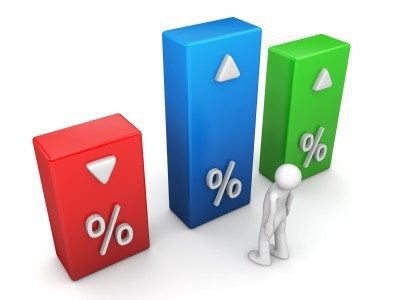Any production process requires constant investments: material, labor, financial, information. Summing up all the cash costs associated with production and sale, you can get the cost of production. This indicator is no less significant than profit, since it is required for calculation gross margin and profitability.
Return on sales according to gross profit, it allows to evaluate the economic efficiency of any enterprise, reflects how rationally material, labor, monetary and other types of resources are used in a particular production.

What is profitability? business?
The gross margin of the enterprise is one of the relative economic indicators economic efficiency. It is measured in percent, calculated by dividing the amount of profit by the sum of all resources expended.
Profitability shows the level of efficiency of use of property assets of the enterprise. By calculating this indicator, you can find out the share of gross profit attributable to each ruble invested in production.

In determining the level of profitability, the total impact of the following factors is assessed:
- sources and structure of capital;
- asset structure;
- use of resources in production;
- current assets prices;
- revenue volume;
- the amount of costs for the reporting period and others.
Gross margin ratio (Gross margin ratio) is an indicator of financial analysis. It illustrates the percentage of gross profit margin of an enterprise and is used in macroeconomic analysis. The indicator allows you to evaluate the performance of large-scale production and industry in the event that there are not enough conclusions when evaluating net profit.

Gross margin formula
Gross margin (KVP) shows what proportion of gross profit brings 1 RUB., proceeds from product sales, how many percent is gross profit in the volume of sales for the enterprise.
| TOVP = GROSS PROFIT / SALES REVENUE = (SALES REVENUE - COSTS) / SALES REVENUE |
In the following way, gross margin is calculated on the balance sheet:
| TOVP = p. 029 Form No. 2 / p. 010 Form No. 2 |
Standard value of gross margin
A single standard value for the indicator of gross margin has not been established. The return on investment in various sectors of the economy is difficult to calculate in detail, therefore, the standards of profitability may vary depending on the industry and the specifics of the enterprise. In the best case, the indicator is characterized by positive dynamics and an upward trend. Its increase means an increase in the share of profit in the structure of revenue.
| Coefficient change | Coefficient value |
|
Growing profitability gross output enterprise means a decrease in the cost of production, and hence an increase in production efficiency. |
|
A decrease in the coefficient reflects an increase in the cost of production, and therefore the efficiency of the use of production assets has decreased. |
|
In the case when the gross margin of an individual enterprise exceeds the average profitability of the industry, we can say that it uses production capacities more efficiently than other enterprises of the industry. |
|
In the event that the gross margin of an individual enterprise is lower than the average profitability of the industry, then the profitability of its production assets is lower than that of other enterprises in this industry. |
Calculation of gross margin on the example of the financial results of OAO Gazprom, thousand rubles
| Name of indicator | Metric code | 3 sq. 2013 | 4 sq. 2013 | 1 sq. 2014 | 2 sq. 2014 |
| 1. Revenue | 2110 | 2 817 073 968 | 3 933 335 313 | 1 189 064 141 | 2 111 605 635 |
| 2. Cost of sales | 2120 | - 1 403 119 412 | - 1 927 337 089 | - 510 736 610 | - 979 986 131 |
| 3. Gross profit | 2100 | 1 413 954 556 | 2 005 998 224 | 678 327 531 | 1 131 619 504 |
| 4. Gross margin | - | 50% | 51% | 57% | 54% |
Conclusion: the profitability indicator for the study period has a positive value (from 50% to 57%). Consequently, production assets of enterprises are stable and efficiently functioning.
Indicator application
Gross margin is a comprehensive measure of performance by specific types of profitability. Using its calculation, you can evaluate the effectiveness of the commercial departments of any enterprise. Another accurate indicator of effectiveness is net profit (the difference between the income and expenses of the enterprise).
Profitability is the ratio of profit to profitability. Gross margin is often used to evaluate the effectiveness of large investment projects. The amount of return on investment is not easy to calculate and difficult to predict.

Profitability analysis is regularly carried out at any normally operating enterprise. The purpose of this area is to determine the most profitable and most unprofitable areas of business activity, business areas. The results of the analysis are used to select and develop a strategy for each direction, in the long and short term. Strategy is a long-term plan for the development of an enterprise.
If the company has a small staff, and the cash flows passing through the internal reserves of the company are small, then it is very advisable to take into account not only gross margin, but also other profitability indicators. Calculate return on assets, production, investment and sales. This approach will allow timely identification of weaknesses in the enterprise and timely take the necessary measures to reduce their impact on profits. But these indicators do not always fully reflect the real situation at the enterprise in the short term.
Return on sales
Analysis of the level of profitability allows you to identify which type of activity brings more income, and which - losses. The solvency of a legal entity largely depends on the concentration and specialization of production. Profitability of production is a qualitative and generalizing indicator of enterprise performance. It allows you to correlate the total indicator of fixed and current assets with the indicator of net profit.
Profitability of production is determined by the following formula:
| RP = NET PROFIT / (AMOUNT OF WORKING CAPITALS + AMOUNT OF MAJOR FUNDS) |
The significant amount of profit is supported by the low cost of fixed assets and working capital, and the effectiveness of their work. As a result, the profitability of production is maximum, as is the economic efficiency of the enterprise. Return on sales reflects the profitability and efficiency of the enterprise’s operations.
Return on sales
The level of profitability is a fairly simple mechanism for assessing production efficiency in three areas: financial, investment and operational activities. It allows you to determine what profit each ruble invested in assets gives. It is calculated as follows:
| AtRP = OPERATING PROFIT / REVENUE * * 100% |
Profit and Profitability Analysis
The main information sources for the analysis of profit and profitability are: form No. 2 and form No. 5. Analysis of profit and profitability is carried out in stages: the study of the amount and level of indicators of profit and profitability in dynamics.Determination of actual deviations from the planned.
The considered indicators are compared by quarters, months. The level of variability of indicators is estimated. The analysis of deviations allows you to determine the total level of risk associated with the formation of profit.

The absolute amount of profit does not allow to fully weigh the profitability of the enterprise or commercial transaction. Enterprises with the same profit often differ in terms of sales and costs. Therefore, to assess the effectiveness of activities calculated profitability, gross profit.
The next stage of the analysis involves the study of factors that influenced the process of generating profits and profitability before tax. Factors are a factor system and are analyzed for the enterprise as a whole and for individual areas. Actual data are compared with the baseline in the amount and specific gravity. The structure of profit formation before taxation is studied, the ratio of profit from sales of products to individual types of activities is calculated. Attention should be paid to the mutually affecting factors indirectly and directly related to the formation of profit.
What does increasing profitability mean?
Profitability level is a ratio of profit to expenses. Profit is correlated with the volume of commodity circulation, with the sum of fixed and current assets, with the value of fixed capital, current assets, etc.
Increasing profitability means that the financial position of the company is strengthening. This has a positive effect in the life of the entire staff of the company: an increase in the wage fund, social protection. The owners of the enterprise receive confirmation that the implemented management decisions were effective, the chosen management tactics were appropriate. From the point of view of the state, a high level of profitability is an increase in the volume of funds allocated to the budget.
For partners and investors, an increase in profitability is also a signal that the market value of the enterprise is increasing, cooperation with it is promising, it is profitable to invest in it.

Efficiency mark
At any enterprise, there is a relationship of resources, costs and end results. For the effective development of production, the following conditions must be met:
| Ip> Io> Ii> If> Ich
- IP - profit growth index; - Io - growth index of commodity circulation; - AI - growth rate of distribution costs; - If - growth ratio of capital-labor ratio; - Ich - the index of growth in headcount. |
In order to assess the effectiveness of the organization, a number of profitability indicators are used: the ratio of profit to distribution costs, the wage fund, the rate of profit per 1 m2 retail space, per 1 average employee.

Conclusion
Profitability, gross income of the enterprise are one of the main economic indicators of economic activity. Gross profit margin or profitability shows whether the organization effectively uses its property assets, how much profit is accounted for each ruble invested in production.
The gross margin formula is used in macroeconomic analysis. The profitability ratio reflects the profitability of the enterprise in terms of gross profit in percent and allows, along with other economic indicators, to further evaluate the performance of large-scale production and industry.








